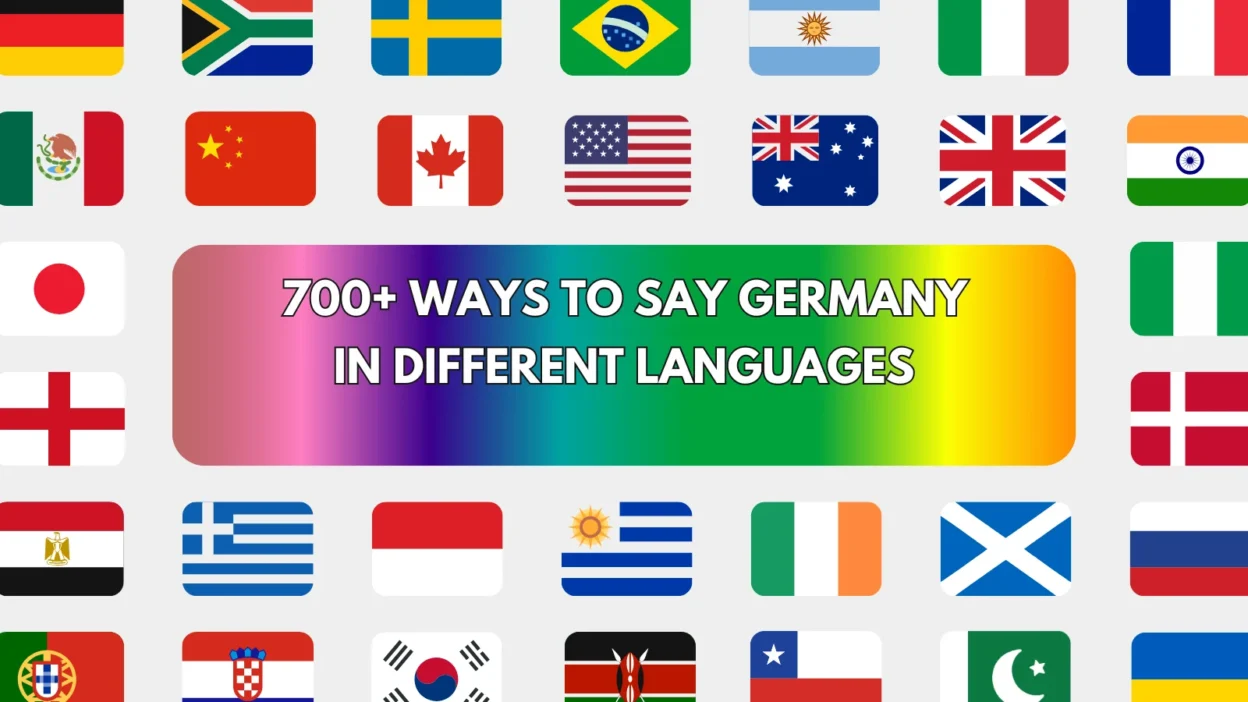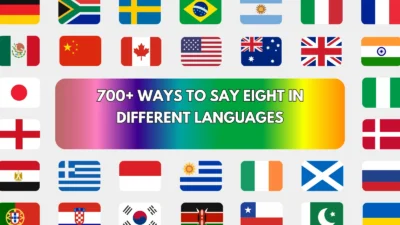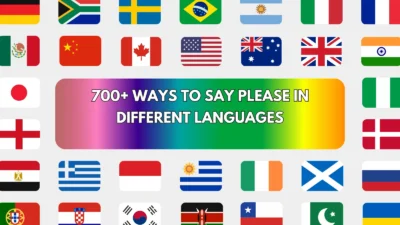Germany — a country famous for its rich history, engineering excellence, cultural influence, and beautiful landscapes — is called by many different names around the world. From Deutschland to Alemania, each language has its own unique way of referring to this central European nation.
Let’s explore how to say “Germany” in 70 different languages, complete with pronunciations and example sentences.
How to Say “Germany” in 70 Different Languages
- German 🇩🇪 – Deutschland | DOYTCH-lahnd
Deutschland ist wunderschön. (Germany is beautiful.) - Spanish 🇪🇸 – Alemania | ah-leh-MAH-nyah
Alemania ist sehr schön. (Germany is very beautiful.) - French 🇫🇷 – Allemagne | al-MAHN-yuh
L’Allemagne est un pays fascinant. (Germany is a fascinating country.) - Italian 🇮🇹 – Germania | jer-MAH-nyah
La Germania ha una lunga storia. (Germany has a long history.) - Portuguese 🇵🇹 – Alemanha | ah-leh-MAH-nyah
A Alemanha é incrível. (Germany is amazing.) - Dutch 🇳🇱 – Duitsland | DOYTSS-lahnd
Duitsland is prachtig. (Germany is beautiful.) - Russian 🇷🇺 – Германия (Germaniya) | gheer-MAH-nee-ya
Германия — красивая страна. (Germany is a beautiful country.) - Mandarin Chinese 🇨🇳 – 德国 (Déguó) | duh-gwoh
德国很发达。 (Germany is developed.) - Japanese 🇯🇵 – ドイツ (Doitsu) | do-ee-tsu
ドイツは美しい国です。 (Germany is a beautiful country.) - Korean 🇰🇷 – 독일 (Dogil) | doh-geel
독일은 역사 깊은 나라입니다. (Germany is a country with deep history.) - Hindi 🇮🇳 – जर्मनी (Jarmani) | jar-mah-nee
जर्मनी अद्भुत है। (Germany is wonderful.) - Bengali 🇧🇩 – জার্মানি (Jarmani) | jar-mah-nee
জার্মানি সুন্দর দেশ। (Germany is a beautiful country.) - Urdu 🇵🇰 – جرمنی (Germany) | jer-muh-nee
جرمنی ایک خوبصورت ملک ہے۔ (Germany is a beautiful country.) - Arabic 🇸🇦 – ألمانيا (Almanya) | al-MAN-ya
ألمانيا بلد رائع. (Germany is a wonderful country.) - Turkish 🇹🇷 – Almanya | al-MAN-yah
Almanya çok güzel. (Germany is very beautiful.) - Greek 🇬🇷 – Γερμανία (Germanía) | yer-ma-NEE-a
- Hebrew 🇮🇱 – גרמניה (Germania) | ger-MAH-nee-ya
- Persian 🇮🇷 – آلمان (Ālmān) | al-mahn
- Swahili 🇹🇿 – Ujerumani | oo-jeh-roo-mah-nee
- Zulu 🇿🇦 – iJalimane | ee-jah-lee-mah-neh
- Afrikaans 🇿🇦 – Duitsland | DOYTSS-lahnd
- Somali 🇸🇴 – Jarmal | jar-mal
- Amharic 🇪🇹 – ጀርመን (Jermen) | jer-men
- Yoruba 🇳🇬 – Jámánì | jah-mah-nee
- Hausa 🇳🇬 – Jamus | jah-moos
- Polish 🇵🇱 – Niemcy | nyem-tsih
- Czech 🇨🇿 – Německo | nyeh-mets-ko
- Slovak 🇸🇰 – Nemecko | nyeh-mets-ko
- Hungarian 🇭🇺 – Németország | nay-met-or-sahg
- Finnish 🇫🇮 – Saksa | sahk-sah
- Swedish 🇸🇪 – Tyskland | TISS-kland
- Norwegian 🇳🇴 – Tyskland | TISS-kland
- Danish 🇩🇰 – Tyskland | TISS-kland
- Icelandic 🇮🇸 – Þýskaland | thees-ka-land
- Irish 🇮🇪 – An Ghearmáin | on yar-MAWN
- Scottish Gaelic 🏴 – A’ Ghearmailt | uh YER-malt
- Welsh 🏴 – Yr Almaen | ur AL-mine
- Maltese 🇲🇹 – Il-Ġermanja | eel jer-MAHN-ya
- Latvian 🇱🇻 – Vācija | VAH-tsi-ya
- Lithuanian 🇱🇹 – Vokietija | voh-kyeh-TEE-ya
- Estonian 🇪🇪 – Saksamaa | sahk-sah-mah
- Ukrainian 🇺🇦 – Німеччина (Nimechchyna) | nee-meh-chy-nah
- Belarusian 🇧🇾 – Германія (Hermanija) | her-mah-nee-ya
- Serbian 🇷🇸 – Немачка (Nemačka) | neh-mahch-ka
- Croatian 🇭🇷 – Njemačka | nyeh-mahch-ka
- Bosnian 🇧🇦 – Njemačka | nyeh-mahch-ka
- Slovenian 🇸🇮 – Nemčija | nem-chee-ya
- Bulgarian 🇧🇬 – Германия (Germaniya) | ger-mah-nee-ya
- Macedonian 🇲🇰 – Германија (Germanija) | ger-mah-nee-ya
- Albanian 🇦🇱 – Gjermania | jyer-mah-nee-a
- Romanian 🇷🇴 – Germania | jer-mah-nee-a
- Kazakh 🇰🇿 – Германия (Germaniya) | ger-mah-nee-ya
- Uzbek 🇺🇿 – Germaniya | ger-mah-nee-ya
- Kyrgyz 🇰🇬 – Германия | ger-mah-nee-ya
- Tajik 🇹🇯 – Олмон (Olmon) | ol-mon
- Georgian 🇬🇪 – გერმანია (Germania) | ger-mah-nee-a
- Armenian 🇦🇲 – Գերմանիա (Germania) | ger-mah-nee-a
- Azerbaijani 🇦🇿 – Almaniya | al-mah-nee-ya
- Thai 🇹🇭 – เยอรมนี (Yoeramani) | yuh-rah-mah-nee
- Vietnamese 🇻🇳 – Đức | duk
- Khmer 🇰🇭 – អាល្លឺម៉ង់ (Allemagne) | ah-luh-mong
- Lao 🇱🇦 – ເຢຍລະມັນ (Yoe-laman) | yuh-lah-man
- Malay 🇲🇾 – Jerman | jer-man
- Indonesian 🇮🇩 – Jerman | jer-man
- Filipino 🇵🇭 – Alemanya | ah-leh-mah-nyah
- Hawaiian 🇺🇸 – Kelemānia | keh-leh-mah-nee-ah
- Maori 🇳🇿 – Tiamana | tee-ah-mah-nah
- Samoan 🇼🇸 – Siamani | see-ah-mah-nee
- Tongan 🇹🇴 – Siamani | see-ah-mah-nee
- Esperanto 🌐 – Germanio | ger-mah-nee-o
Conclusion
From Deutschland in German to Alemania in Spanish, the name “Germany” reflects centuries of cultural exchange, trade, migration, and diplomacy. Each language’s version carries its own history — some derived from Latin roots, others shaped by old tribal names or linguistic evolution. No matter the pronunciation, the identity of Germany as a land of innovation, tradition, and beauty is recognized worldwide.




